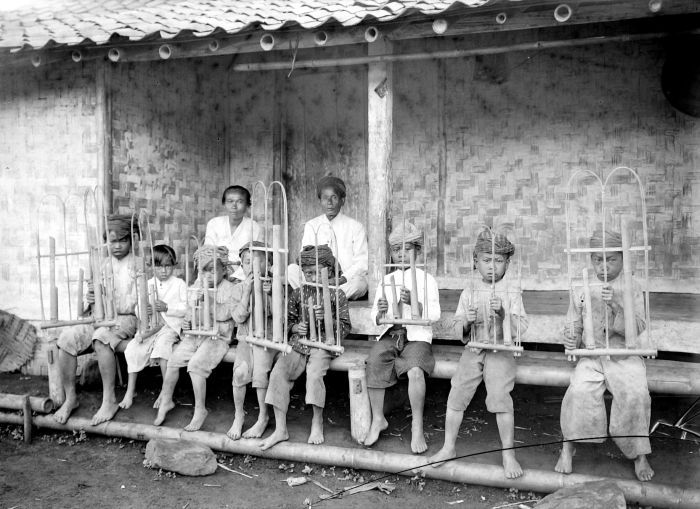
Assalamualaikum
Welcome to another edition of English Corner, my name is Rifki Kusmana. This is an article about Sundanese music, a small break from my regular writings.
An Indonesian version of this article is available here.
Sundanese music is an umbrella term that encompasses the diverse musical traditions that developed in the Sundanese communities in the western part of the island of Java.
Sundanese people are sometimes incorrectly referred to by foreigners as Javanese. Sundanese culture, language and music are very different from the Javanese of Central and East Java – although of course there are also elements that show similarities. In Sunda there is a bewildering diversity of musical genres, musical compositions and very different tuning systems.
Genre Examples
Tembang Sunda
Tembang Sunda, also called seni mamaos cianjuran, or simply cianjuran, is a form of chanted poetry that emerged during the colonial period in Cianjur. It was first recognized as an aristocratic art; one of the creators of cianjuran was RAA Kusumahningrat (Dalem Pancaniti), the ruler of Cianjur (1834-1862). Cianjuran instruments are kacapi indung, kacapi rincik and suling or bamboo flute, and rebab for salendro compositions. Lyrics are usually sung in free verse, but a more modern version, panambih, is metric, usually drums.
Bajidoran
Bajidoran is an art form originating from West Java. The uniqueness of this art compared to previously existing arts is in the position of the artists, dance patterns, and music. The position of the sinden or ronggeng (dancer) is on stage and does not mingle with the audience; there are structured dance patterns and there are also free dance movements of dancers and bajidor which are influenced by pre-existing dances. Songs performed include Kidung (Kembang Gadung), traditional kliningan songs (lagu ageung, lagu alit), new creation songs, and also include pop and dangdut songs.
Tarawangsa
Tarawangsa is a type of traditional agrarian community art in West Java. Tarawangsa performances in each region have different forms and structures. Tarawangsa performances in the Rancakalong region, the performance is not equipped with vocals, only two instruments, namely jentreng and tarawangsa. While the art of tarawangsa in Cibalong District, Tasikmalaya Regency is called Calung Tarawangsa, equipped with other instruments.
Contoh-contoh alat musik tradisional
In Sundanese music the term musical instrument or sound produced and played in various ways is called Waditra.
Suling, mostly made of tamiang bamboo (Schizostachyum blumei, Nees), is a long, thin-walled bamboo tube. The mouthpiece of the suling is encircled with a thin ribbon of rattan near a small hole.
Angklung, a musical instrument consisting of two to four bamboo tubes suspended in a bamboo frame, tied with rattan strings. The tubes are carefully cut and trimmed by master craftsmen to produce specific tones when the bamboo frame is shaken or tapped. Each angklung produces one note or chord, so several players must collaborate to play a melody. On November 18, 2010, UNESCO officially recognized Indonesian angklung as a Masterpiece of the Oral and Intangible Heritage of Humanity.
Calung, consisting of several bamboo tubes that are struck at the base to produce a woody sound.
Kendang, a musical instrument made from jackfruit, coconut or cempedak wood. Buffalo skin is often used for the bam (the inferior surface that emits low pitch beats) while soft goat skin is used for the chang (the superior surface that emits high pitch beats).
Kacapi, the instrument has a resonance box with the bottom open to allow sound to escape, the sides of this type of kacapi taper inward from top to bottom, which gives the instrument a boat shape. In ancient times, it was made directly from solid wood through holes.
Contemporary Music
Sundanese pop is Indonesian pop music that is a fusion of traditional Sundanese music with contemporary western pop music.
Sundanese dangdut also called Rampak is a regional dangdut music in Indonesia that has traditional Sundanese rhythms and lyrics using Sundanese language.
Music Example
Using Es Lilin as an example, this is the original traditional song:
The song was also covered by Khatia Buniatishvili, with Piano and other western instruments:
And that’s it for today’s English Corner, I hope you have enjoyed this article and I hope to see you again. Thank you for reading and Happy New Year!
Editor: Rifki Kusmana
Editor of the MDF English Corner





Komentar